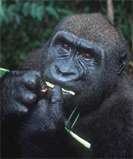Get
To Know
|
 The Western Lowland Gorilla lives in montane, primary and secondary
forests and lowland swamps in central Africa where they eat around
19 kg of roots, shoots, fruit, wild celery, tree bark and pulp which
is provided for in the thick forests. Their black skin along with
coarse black hair that covers their entire body except for the face,
ears, hands, and feet. At the largest, they can stand at 1.5-1.8
m tall and weigh 140-270 kg. They travel within a home range averaging
8-45 sq Km and usually go as far as 5-3 km per day in family groupings
of 4 to 8 members in each. The leader organizes group activities,
like eating, nesting, and traveling in their home range. Females
do not reach sexual maturity until the age of 8 or 9 when they can
give birth to one infant after a pregnancy of nearly nine months.
The infants ride on their mothers' backs from the age of four months
through the first two or three years of their lives and can be dependent
on their mother for up to five years. Their intelligence can be
seen through their ability to fashion tools by selecting branches,
remove projections such as leaves and bark, and adapting their length
to the depth of the holes. Koko, a trapped gorilla mastered more
than 1,000 signs in order to communicate with her human captors.
A number of factors threaten their extinction. They are hunted illegally
for their skins and meat in Africa and captured to be sold to zoos,
and they are affected by deforestation, farming, grazing, and the
expanding human settlements that cause forest loss.
The Western Lowland Gorilla lives in montane, primary and secondary
forests and lowland swamps in central Africa where they eat around
19 kg of roots, shoots, fruit, wild celery, tree bark and pulp which
is provided for in the thick forests. Their black skin along with
coarse black hair that covers their entire body except for the face,
ears, hands, and feet. At the largest, they can stand at 1.5-1.8
m tall and weigh 140-270 kg. They travel within a home range averaging
8-45 sq Km and usually go as far as 5-3 km per day in family groupings
of 4 to 8 members in each. The leader organizes group activities,
like eating, nesting, and traveling in their home range. Females
do not reach sexual maturity until the age of 8 or 9 when they can
give birth to one infant after a pregnancy of nearly nine months.
The infants ride on their mothers' backs from the age of four months
through the first two or three years of their lives and can be dependent
on their mother for up to five years. Their intelligence can be
seen through their ability to fashion tools by selecting branches,
remove projections such as leaves and bark, and adapting their length
to the depth of the holes. Koko, a trapped gorilla mastered more
than 1,000 signs in order to communicate with her human captors.
A number of factors threaten their extinction. They are hunted illegally
for their skins and meat in Africa and captured to be sold to zoos,
and they are affected by deforestation, farming, grazing, and the
expanding human settlements that cause forest loss.
|
|
|
|
Small groups of people will contend
Over limited resources, access
To water, land, the opposing force's breeding stock.
Individuals usually vie over status,
Which is largely the same thing:
He who leads and has first take
Of the collective wealth,
Has first pick of the eligible mates,
Or takes them all and ensures
A superior crop of dominant progeny.
Nations are another matter. There is
That resource competition. And in the mass
Violence there is replay of individual
Dominance and submission. But
In the organization of it you begin to see
A systems model evolve - an interplay
Of cyclic renewal, a circle of causality.
You stagger into the suspicion
Of intimate reasons, of how this contest
Affects the homefront, of who within
The ranks of any one combatant
Wins and loses, of who has the blood
And froth and sweat on the lips
And who has the leftover once-communal wealth.
Wait a minute, you say,
Just what are we really accomplishing here?
And then at two in the morning
The police come knocking at your door
With the comforting black hood and
Plastic ties and you understand
Recanting is part of the plot, too.
Ken’s latest collection of short, wiry fiction, “Constant
Animals”, and his latest collection of surprising poetry, “Victims of
a Failed Civics”, can be obtained from Barking Moose Press, at Barking
Moose Press, or Amazon, or Sundial
Books. He often serves as strange, bewildering eye-candy at his
wife’s power lifting affairs. His poetry of late has been sunning in
“Analog”, “Asimov’s”, “Poet Lore”, “The Kentucky Review”; and his fiction
has yowled in “Spank the Carp”, “Red Truck”, “Café Irreal”, “Bellows
American Review”. More to come.
|
 The
Lowland Gorilla - Issue Twenty-Seven
The
Lowland Gorilla - Issue Twenty-Seven